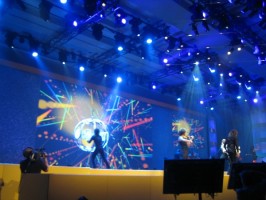 Some notes from the Lotusphere 2011 OGS – the opening, which as always is designed to be inspirational, theme-setting and energizing. Like last year it started off with loud music to awake everyone (well, smart idea when you know that yesterday evening’s welcome reception party was prolonged by many at other places …).
Some notes from the Lotusphere 2011 OGS – the opening, which as always is designed to be inspirational, theme-setting and energizing. Like last year it started off with loud music to awake everyone (well, smart idea when you know that yesterday evening’s welcome reception party was prolonged by many at other places …).
And like last year there was a surprise guest for the opening, actor Kevin Spacey. Some grounded remarks on collaboration, social networks, helping people achieve their potential and the social responsibility of mentoring. Plus – again – some rationale for collaborative social business, ie. based upon his personal insight into filmmaking as an effort of many and the need to lower the walls for innovative ideas to come inside one’s organization and social sphere. Yes, the movie industry can be understood as an archetypical model of networked collaboration and Kevin tells us the story of how he and partners founded a web based platform for scriptwriters years ago – helping them not only to turn in their scripts but also to help them learn from each other. And yes. that was long before the social network.
Then regular Lotus time with Alistair Rennie expanding upon this year’s theme Get social. Do business. Some takeaways from his talk:
- social business is all about a new business context emerging, both in terms of open tasks and opportunities. We need to help business people to solve hard problems, problems that are keeping them awake at night. Read business volatility, the changing nature of customer relationships, et al.
- creative leadership needs to tap and redesign relationships, in order to leverage collective intelligence
- social business is a real game changer, and we know that game changers are rare. Here we have one for sure, even when the model and its understanding is still in the early stages. Why? Because we (and that’s not only IBM but us) have been thinking and researching on this since years literally. IBM wants to lead this movement.
- evolution from mainframes to departmental computing, then PCs on every desk, then the Internet – now it’s stage five, ie. Social Business.
- Companies that employ social technologies Social businesses outperform their competitors according to a recent McKinsey study. It’s because they’re more engaged, more transparent and more nimble and agile (able to change and adapt quickly and able to act with speed). Being engaged in networked social business, ie. working the networks pays as well – when they’re transparent it’s easier to tap distributed competencies and capabilities
- What social business needs is open standards – best served with enterprise grade security. IBM is commited to standards, be they HTML5, activity streams, open social, or else.
- Activity Streams are the cornerstone of the smarter knowledge workers environment, aggregating information from all kinds of sources (be they internal or external social media). And these streams can be accessed and worked on when on the go as well (unified communications as well). So, mobility is another key thing. Clients on all kinds of devices and platforms.
Now some notes from the following panels and demos, starting with RIM CTO Jim Basillie who came onstage with a RIM Playbook (multi-tasking and flash support included unlike other market playbooks ;). He’s holding it’s a viable platform (well, he’s got a point, at least it’s “CIO approved”).
Jeff Schick moderated a customer panel (with BASF, KBC, CSC and AT&T) on how they employ social Lotus software (plus some remarks on how it played out economically, I noted one thing that the guy from BASF said that it’s no longer a mere question of RoI at their place by now, they have demonstrated that it’s worthwhile and have crossed the Rubicon it seems).
Another customer panel with the AFL (he**, australian english is so hard to understand, mymy), the Massachussetts Blue Cross Blue Shield and RBC, big canadian bank. All perfectly satisfied with what they’ve done with Lotus so far.
Then introduction to the demo rounds, reaching back to last year’s Project Vulcan blueprint roadmap vision, the Vulcan ideas get integrated into Notes next, Connections next, Sametime next, xyz next. The idea is to provide exceptional work experience (shall I say with the goal of improving day to day corporate work?). Find some notes on the demos at Alex Williams who was live-blogging the event, Alan Lepofsky was also live-blogging the opening session and has more details of the demos.
After that I was off to the official press conference and a round of executive meetings and briefings during the most time of the afternoon (there will be more posts, stand by … I was writing this post during the whole of the afternoon, ie. during the breaks in my schedule)
PS. Luis Benitez embedded the Lotus live-blogging Cover it Live collaboration of him and Mitch (cool pictures and loads of short remarks made during the session)
PPS. You can see the whole 2:30 video footage of the OGS here: